Herbert Marple was born in October 1890 in Fredericktown, Ohio, to baker George McLeland Marple and his wife Estella Little. His younger brother Raymond Marple came along two years later in September 1892. The family subsequently moved to Hastings, Michigan, where they were found in 1900 with George listed as a baker. Not much is known of Herbert's upbringing in music, but there are clues that Stella was somewhat musical, and may have had a hand in his training.
At some point between 1908 and 1910, the Marple family briefly became involved with the Albion Opera House, built in 1869, and managed at that time by H.H. Sheldon. With a capacity of 750,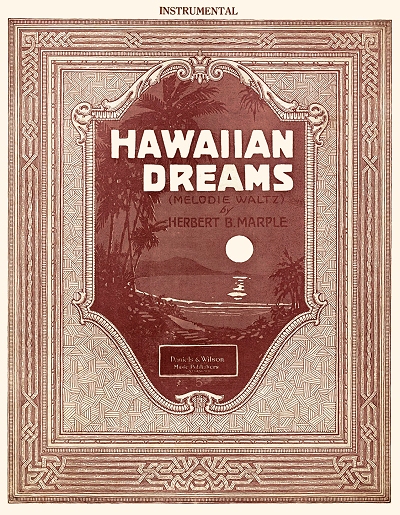 it was fairly large for a small town. By the time of 1910 census it featured more than operas, hosting vaudeville troupes, and displaying motion pictures as well. George was listed as the "superintendent" of the building, while Herbert and his mother Stella were musicians. Raymond, at 17, was in charge of the motion picture end of the business. Within a couple of years, George had returned to his occupation as a baker. Herbert continued to play music, and after marrying Theresa Veronica Cronis (could also be Crowley) in 1915, moved to the Barbary Coast to try and make a living there.
it was fairly large for a small town. By the time of 1910 census it featured more than operas, hosting vaudeville troupes, and displaying motion pictures as well. George was listed as the "superintendent" of the building, while Herbert and his mother Stella were musicians. Raymond, at 17, was in charge of the motion picture end of the business. Within a couple of years, George had returned to his occupation as a baker. Herbert continued to play music, and after marrying Theresa Veronica Cronis (could also be Crowley) in 1915, moved to the Barbary Coast to try and make a living there.
 it was fairly large for a small town. By the time of 1910 census it featured more than operas, hosting vaudeville troupes, and displaying motion pictures as well. George was listed as the "superintendent" of the building, while Herbert and his mother Stella were musicians. Raymond, at 17, was in charge of the motion picture end of the business. Within a couple of years, George had returned to his occupation as a baker. Herbert continued to play music, and after marrying Theresa Veronica Cronis (could also be Crowley) in 1915, moved to the Barbary Coast to try and make a living there.
it was fairly large for a small town. By the time of 1910 census it featured more than operas, hosting vaudeville troupes, and displaying motion pictures as well. George was listed as the "superintendent" of the building, while Herbert and his mother Stella were musicians. Raymond, at 17, was in charge of the motion picture end of the business. Within a couple of years, George had returned to his occupation as a baker. Herbert continued to play music, and after marrying Theresa Veronica Cronis (could also be Crowley) in 1915, moved to the Barbary Coast to try and make a living there.While in the San Francisco Bay Area in California, Herbert hooked up with another transplant, composer and publisher Charles N. Daniels who had relocated from the Midwest for the benefit of his daughter's health, who had died by 1915. Herbert brought his song Hawaiian Dreams to Daniels for publication, and it quickly was deemed popular enough to warrant a song version as well, with lyrics by Daniels under the pseudonym Sidney Carter, released by Daniels and his partner Weston Wilson. It was soon recorded, one rendition committed to an Edison Blue Ambersol cylinder by the Waikiki Hawaiian Orchestra.
In 1917 Herbert published his only rag, Lucky Dog - Stop Rag, a fine and interesting syncopated piece. It was released under the banner of the short-lived Car-Vin company, a music jobber firm that Marple managed in 1917 and 1918. It has an ad on the back for another publication from the prior year, but Marple's role in this prior piece is unclear. They may have done some of the printing work for the larger San Francisco music store and publisher, Sherman Clay & Company among others. Marple's draft record of that same year shows Herbert and Theresa living in San Francisco, and a manager at Car-Vin situated at 233 Post Street.
Marple and Daniels, likely encouraged by the success of Hawaiian Dreams, scored again in 1918, although on a smaller scale. Arabian Dreams, published by Daniels and Wilson and released both as a song and instrumental, had tepid sales compared to its successor.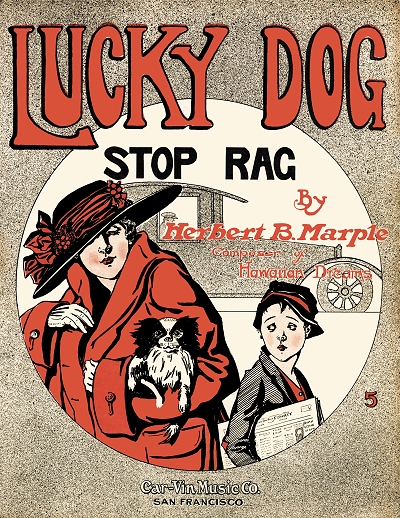 That same year Herbert became involved with the Sherman Clay & Company. It was announced in March 1918 that "Car-Vin, the well-known sheet music jobbers of [San Francisco], have sold their entire stock and have retired from business. H. B. Marple, manager of Car-Vin, has been appointed traveling salesman for Sherman, Clay & Co., and other members of the old organization have also joined this house." He was doing very well as a composer with his contemplative Roses at Twilight, with lyrics by Ben Black. This piece was advertised in 1918 and 1919 in newspapers throughout the country, and sold briskly. It was also featured on at least two piano roll renditions. He followed this up in 1919 with Old Virginny. A 1918 voting roll shows the Marples living in Alameda county at 77 Echo Avenue, and he is listed as a manager.
That same year Herbert became involved with the Sherman Clay & Company. It was announced in March 1918 that "Car-Vin, the well-known sheet music jobbers of [San Francisco], have sold their entire stock and have retired from business. H. B. Marple, manager of Car-Vin, has been appointed traveling salesman for Sherman, Clay & Co., and other members of the old organization have also joined this house." He was doing very well as a composer with his contemplative Roses at Twilight, with lyrics by Ben Black. This piece was advertised in 1918 and 1919 in newspapers throughout the country, and sold briskly. It was also featured on at least two piano roll renditions. He followed this up in 1919 with Old Virginny. A 1918 voting roll shows the Marples living in Alameda county at 77 Echo Avenue, and he is listed as a manager.
 That same year Herbert became involved with the Sherman Clay & Company. It was announced in March 1918 that "Car-Vin, the well-known sheet music jobbers of [San Francisco], have sold their entire stock and have retired from business. H. B. Marple, manager of Car-Vin, has been appointed traveling salesman for Sherman, Clay & Co., and other members of the old organization have also joined this house." He was doing very well as a composer with his contemplative Roses at Twilight, with lyrics by Ben Black. This piece was advertised in 1918 and 1919 in newspapers throughout the country, and sold briskly. It was also featured on at least two piano roll renditions. He followed this up in 1919 with Old Virginny. A 1918 voting roll shows the Marples living in Alameda county at 77 Echo Avenue, and he is listed as a manager.
That same year Herbert became involved with the Sherman Clay & Company. It was announced in March 1918 that "Car-Vin, the well-known sheet music jobbers of [San Francisco], have sold their entire stock and have retired from business. H. B. Marple, manager of Car-Vin, has been appointed traveling salesman for Sherman, Clay & Co., and other members of the old organization have also joined this house." He was doing very well as a composer with his contemplative Roses at Twilight, with lyrics by Ben Black. This piece was advertised in 1918 and 1919 in newspapers throughout the country, and sold briskly. It was also featured on at least two piano roll renditions. He followed this up in 1919 with Old Virginny. A 1918 voting roll shows the Marples living in Alameda county at 77 Echo Avenue, and he is listed as a manager.Having been tasked by Sherman Clay as their primary traveling representative, Herbert went out on the first two of his extended road trips in 1918. The first in the Spring was to the Northwest cities, and the second starting in September 1918 took him back East for the first time. This journey was closely followed by The Music Trade Review, which reported some of his stops. On March 22, 1919, the paper noted that: "Herbert Marple, who has been on the road for the sheet music department of Sherman, Clay & Co. since last September, is expected to return home next week. During his absence Marple has traveled more than 15,000 miles and has visited every music center of importance in the United States." He also made several stops in southern Canada during the long journey. Whether Theresa accompanied him on this trip or not was not documented.
Herbert's parents had remained in Michigan, and George and Stella appear there in Eaton Rapids in 1920 with George still plying his trade as a baker. It appears that Herbert may have gone back East briefly to work with publisher Jack Robbins around this time. He and Theresa were not found in the 1920 census, and he was most likely in transit. In February 1920, Sherman Clay manager Ed Little announced a push to disseminate their sheet music products throughout the United States, with Marple as his primary representative. A second promotional tour was made in 1920 by Marple and his colleague Harvey Orr, with the primary songs promoted being Louisiana and the highly popular Whispering. Both Presto and The Music Trade Review followed his progress with sightings in Portland, Oregon, Seattle, Washington, and ultimately Chicago before the pair returned home. As noted in Presto on April 24, 1920:
Herbert B. Marple, traveling representative of the Sherman, Clay Co., San Francisco, was in Portland last week doing a big business, taking more orders than ever before for the firm he represents. While Mr. Marple is an excellent business man, it is not only in that connection that he is well known, but he is one of the most popular composers. His song, 'Hawaiian Dreams,' has been one of his most successful compositions, over 1,000,000 copies having been sold, and 'Roses at Twilight' has already reached the 750,000 mark.
Another more detailed article from the September 25, 1920 Music Trade Review reads as follows:
Messrs. Marple and Orr, of Sherman, Clay & Co's Sales Staff, Visiting Eastern Points
In the old days it used to be 'Go West, young man, go West.' Two young men from the sales staff of Sherman, Clay & Co., San Francisco, Cal., Herbert Marple and Harvey Orr, have taken those instructions to heart in the reverse form and have started East by automobile. They are visiting the trade in the country through which they pass and in the very near future, as they were only recently in Kansas City, Mo., they will have reached New York. After all, it is quite a unique trip and The Review knows no other sheet music salesmen who have ever proceeded overland through such Far Western country in the interests of their firms' publications. According to reports, Sherman, Clay & Co.'s song and instrumental success, 'Whispering,' has proved one of the biggest hits in the territory visited.
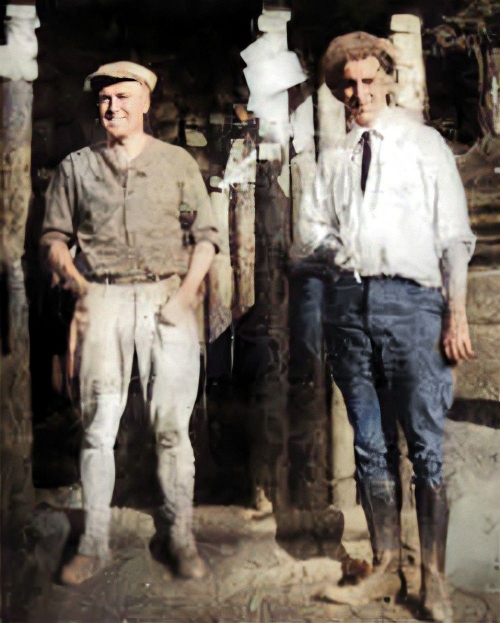 |
We herewith reproduce a photograph taken of the two boys in the wilds of the Yosemite Valley, where, it is said, they were resting after a five-mile hike up the mountains to Iron Rock, which overhangs the world-famous Nevada Falls. We have also received a report that they are shown contemplating singing 'Have You Forgotten'? There is some dispute regarding this latter inasmuch as some assume that they would not have had sufficient lung power left after such a climb to do the song justice and we can hardly picture such enthusiastic young men singing a Sherman, Clay number in anything but their finest voices.
By the end of 1921 the Marple was back in San Francisco.
Herbert is mentioned in Sheet Music News in 1922 as the manager of Sherman Clay, recovering from a recent illness, and planning yet another extended trip through the Northwest. He made a trip to Southern California in February of that year, which may have led to his next career move. Around the same time Harry worked up an adaptation of Song of India, a theme by Nikolav Rimsky-Korsakov, into a popular song. It was quickly picked up by the Paul Whiteman Orchestra and remained a favorite through the Swing Era of the mid-1930s to 1940s. However, he had another move in mind, going south to Los Angeles.
As reported in The Music Trade Review of October 7, 1922: "Harry G. Neville, who has been manager of G. Schirmer Co. for many years, has obtained the sheet music concession at the Platt Music Co., on Broadway [downtown Los Angeles], and will be open for business about October 1, when the extensive alterations and improvements which have been under construction for some time are completed. The new firm will be known as the Neville-Marple Music Co. Mr. Neville and Mr. Marple, formerly with Sherman, Clay & Co., will undoubtedly make a great success of their new undertaking." By 1924 Herbert and Theresa were registered voters in Los Angeles. The Neville-Marple company soon had a chain of stores in Southern California, in addition to their primary location on Broadway. Harry, who was still working as an agent at large for Sherman Clay, is shown in the 1924 and 1926 voter rolls as a music merchant. As reported in The Music Trade Review of June 19, 1926:
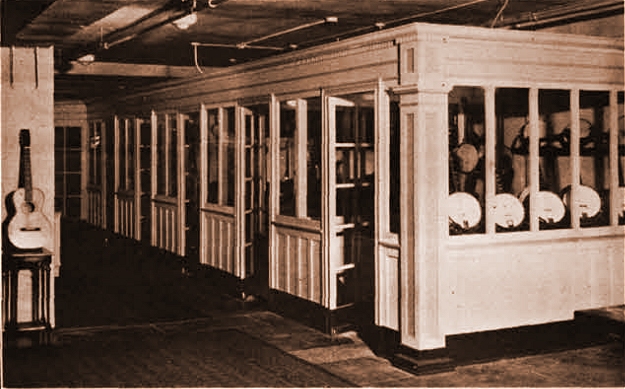 |
Bright and early one morning I interviewed Harry Neville at the Wiley B. Allen Co.'s new home at 720 South Broadway. The store was just about ready for the formal opening. The interior is decorated in gray with cream-colored trimming. The entire store is splendidly laid out and will no doubt prove one of the most attractive music houses on South Broadway. Neville was extremely busy getting his music department in shape. It occupies a great deal of space on the main floor and a large room downstairs for octavo and orchestra music. The Neville Marple Co. operates many stores in this section, or rather in what is called the metropolitan district of Greater Los Angeles...
Unfortunately I was unable to visit with the other member of the firm, Herbert Marple. He spends a good deal of time covering the circuit and I did not see him while I was in the city. The Neville-Marple department at 630 South Hill street is looked after by Colonel DeMotte, the old veteran of the music business on the Pacific Coast. He still enjoys his daily work without a pause and doesn't shirk.
In 1927 Marple's last collaborative composition, Funny Tune, was released, published by the Los Angeles firm of W.A. Quincke & Company. The following year he briefly became a publisher himself, issuing some rearranged piano works for youth, and even a couple of pieces by some of his former San Francisco associates, under the banner of his store, the Neville-Marple Music Company. But that same year Marple took on a new occupation as well, showing in the voter rolls as a Real-Estate agent. Of note, this was the first year that Theresa appeared as well, registered as a Democrat to Herbert's Republican listing.
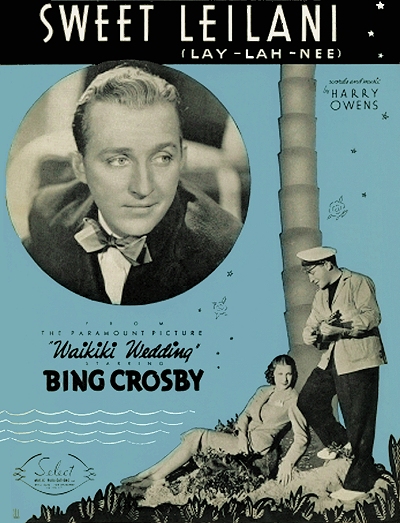 As of the 1930 census, it appeared that Herbert had all but abandoned music for real estate, which is his listed occupation the census. However, he reconnected with Sherman Clay in 1932 following the death of their sheet music manager Ed Little. The Music Trade Review of October, 1932, announced that he had been hired as the general manager of the music publishing division of Sherman, Clay & Company. Whether Herbert maintained two occupations is unclear, as there were no occupations listed in the 1932 voter roll. By 1935 the couple had moved to 6025 Malabar Avenue in Huntington Park near Los Angeles, where they would remain for the rest of their lives. George and Stella had also moved out to Los Angeles and were living with their son and daughter-in-law. All are shown there in the 1936 voter roll with George still working as a baker and Herbert as a manager, but for what is unclear. The same is true for the 1938 roll. Herbert and Theresa evidently never had children.
As of the 1930 census, it appeared that Herbert had all but abandoned music for real estate, which is his listed occupation the census. However, he reconnected with Sherman Clay in 1932 following the death of their sheet music manager Ed Little. The Music Trade Review of October, 1932, announced that he had been hired as the general manager of the music publishing division of Sherman, Clay & Company. Whether Herbert maintained two occupations is unclear, as there were no occupations listed in the 1932 voter roll. By 1935 the couple had moved to 6025 Malabar Avenue in Huntington Park near Los Angeles, where they would remain for the rest of their lives. George and Stella had also moved out to Los Angeles and were living with their son and daughter-in-law. All are shown there in the 1936 voter roll with George still working as a baker and Herbert as a manager, but for what is unclear. The same is true for the 1938 roll. Herbert and Theresa evidently never had children.It was clear that Herbert was still involved with Sherman Clay in the mid-1930s, given a lawsuit in which he was named as a party. According to the Oakland Tribune of November 23, 1939, "Crooner Bing Crosby, Bandman Harry Owens and Paramount Movie Studio were sued for $500,000 today by Myrtle R. Hoffman, who charged her song was stolen not once, but twice for the same picture. Miss Hoffman complained that her tune, 'Roses, Lovely Roses Bring Dreams to Me,' was sung twice by Crosby in his picture 'Waikiki Wedding.' One variation was entitled 'Leilani' and the other 'Sweet Leilani,' she said. Also sued were Sherman Clay & Co. of New York [sic] and its former employee, Herbert B. Marple, who she charged brought a copy of her song here and collaborated with Owens in plagiarizing it." The disposition of the lawsuit was difficult to discover, but it likely did not go very far at that time or there would be a more permanent record of it.
By 1940, George's relations were living next door at 2067 Malabar. Over the next decade that residence would be occupied by Matilda Marple, A.C. Marple and Nellie Marple. But Herbert's mother Stella had died by 1940. It is unknown whether Herbert continued in any capacity with Sherman Clay in Los Angeles or pursued work as occupation listings disappeared in the 1940s. The 1950 census, taken in Huntington Park, showed him working as a piano salesman in a department store, which could have been for Sherman Clay, as they had stores in the area into the 1980s. George had died on July 21, 1948. Theresa followed in 1957. In 1960 Herbert, now approaching 70, was living alone on Malabar. He died in Ventura, California (possibly the hospital in Camarillo) the following January.
Thanks go to the late researcher/performer Nan Bostick, whose great uncle Charles N. Daniels published and co-wrote a couple of Marple's works. She got this biography started with some basic information. The rest was done through research of public and private records and newspapers by the author.
 Compositions
Compositions